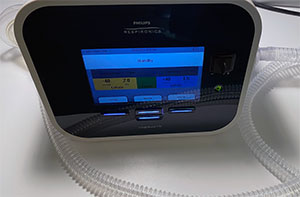Dwellness™ • Cough Assist Instructions
Cough Assist Instructions
Dwellness™ customization for:
Your Patient
Respironics T70 Quick-start (PDF)

General Principles
[NOTE: If the cough assist treatment is aversive, your patient will usually let you know by resisting and trying to push it away. If this happens, patiently encourage your patient and keep trying for a short time. If your patient continues, simply stop the treatment.]
[NOTE: One alternative to cough assist is to get your patient out of your patient's chair and lay your patient down on your patient's side in bed. This is equivalent to the Recovery Position, and will almost always help your patient clear your patient's airway.]
Process
How to tell when cough assist is needed- When your patient has a pulmonary infection or breathing problems
- When there is a suspicion that your patient might have some pulmonary problems
- When your patient is having trouble processing secretions
- Especially when your patient is tired, your patient has more trouble processing secretions
- During certain seasons, use the cough assist to avoid pulmonary problems or infections
- In these cases, perform the entire regimen once or twice daily
- Observe your patient's breathing patterns
- Listen for shallow breath
- Listen for wheezing or rattling
- Listen to how your patient your patient's coughing
- Your patient coughs regularly each day – it should sound like anyone’s cough
- Gagging sound as your patient coughs to expel secretions indicates problems
- Listen to your patient's voice
- Gurgling sound as your patient talks
- Possible nasal sound when your patient pronounces the letters ‘m’ or ‘n’
- Observe your patient's facial expressions and complexion
- Flushed face
- Less expressive, lower energy
Procedures
[NOTE: To address a difficulty processing secretions, the cough assist is often used with other procedures. Study the use of Zofran (Ondansetron) and the Recovery Position as additional tools for dealing with this problem.]
Therapy settings- We use two Preset therapy settings on the cough assist machine
- Preset #3
- "Insufflation" – pushes air into your patient's lungs, then pulls it out – "exsufflation"
- Preset #2
- Pushes air into your patient's lungs – insufflation – but then your patient exhales independently
- This encourages lung expansion
- Both Presets are automatically triggered by your patient's inhalation – "Auto Cough-Trak"
- If your patient holds your patient's breath, the Preset stops and waits until your patient starts it again
[NOTE: If the cough assist is being used every day, replace the circuit and filter once a month. Schedule replacement accordingly if it is not being used every day. Swap the mask for a new one after 20-25 uses.]
- Mask
- A soft, form-fitting mask that is inflatable
- Inflate it enough to hold the hard plastic away from your patient's face, but soft enough to be comfortable under pressure
- Inflation can be varied
- Use a Luer-slip syringe
- The same as used for the G-tube balloon
- Corrugated tubing – "Circuit"
- Filter
- Cough assist unit – Philips brand "Respironics CoughAssist T70 (PDF)"
[NOTE: The Luer-slip syringes are kept in the medication cupboard in the hallway. They are in a plastic bag marked "Luer-slip".]
[NOTE: Remember to "narrate" your actions constantly. Tell your patient what you are going to do before you do it, give your patient a running narration as you do it, and follow up with encouragement.]
[NOTE: During the cough assist treatments, it helps to have a strong distraction. The drum machine has been the most effective at keeping your patient's minds and hands busy during this procedure.]
- Setup
- Remove the cough assist from the case, plug into power, and assemble
- Attach the filter end of the circuit onto the port on the right side of the machine
- Attach the mask to the circuit and set aside
- Press the power button
- Check which Preset is called up
- If it’s not Preset #3, then change it see Cough Assist Quick-start (PDF)
- Therapy
- Press the Therapy button
- Hold your patient's head upright with your hand at the base of your patient's skull
- Place the mask covering your patient's nose and mouth, and apply medium pressure to seal
- As soon as your patient breathes the cough assist will start
- Keep a firm seal
- Encourage your patient to breathe
- Be aware of your patient's comfort and adjust as needed
- Rounds
- Each insufflation and exsufflation is considered one round
- Pause between each round for just a few seconds and encourage coughing
- Have the suction machine ready, in case there are any secretions to clear out
- Be patient and watch for signs of excessive mask pressure on your patient's face
- Sets
- A set is five complete rounds, including the pauses and possible suctioning
- After five rounds, end the set with lung expansion
- At maximum insufflation, remove the mask so your patient exhales independently
- Repetitions
- In a typical cough assist treatment, perform three complete sets
- If the treatment is aversive, your patient will let you know by resisting and complaining
- Patiently encourage your patient to continue
- Try distracting with the drum machine
- If it is too aversive and your patient is not sick, pause treatment until later
- Evenings, when your patient is having trouble processing secretions
- If possible, perform one set of five complete rounds
- If your patient resists, then perform whatever your patient will tolerate
- Always end any use of Preset #3, but remove the mask right after insufflation
- Lung expansion
Dwellness input from HPCA and family caregivers can serve to improve the ongoing support system. Feel free to speak up!
 Dwellness
Dwellness